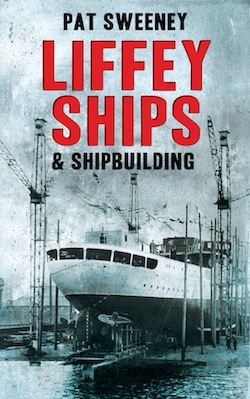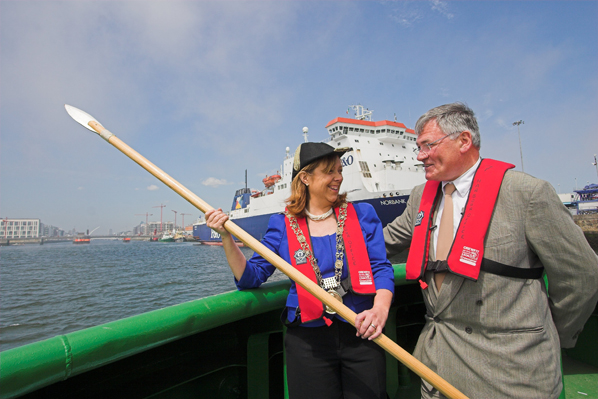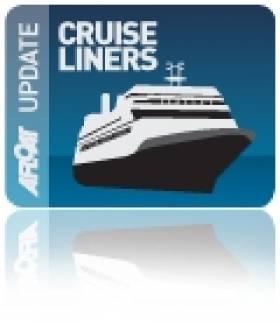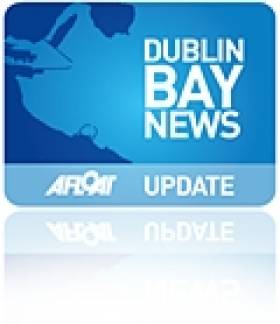Displaying items by tag: Dublin Bay
'Hyfive' Continues Winning Way on Dublin Bay
Zu Wins Windy Dublin Bay Race Tonight
Winds gusting to 20 knots greeted tonight's Dublin Bay Sailing Club fleet for its regular Thursday night league. Peter Dee's Dragon Zu was the winner of the Dragon class. Full sailing results are posted over the fold.
Dublin Port Dublin Bay Sailing Club Results for 15 JULY 2010
Kelly's Storm Wins IRC One in Howth
HOWTH YACHT CLUB. WEDNESDAY SERIES 2 (RACE) 14/07/2010 Class 1 IRC: 1, Storm P Kelly; 2, Makutu Doyle/Others; 3, Tiger Hughes/Harris; Class 1 HPH: 1, Joslim J Connolly; 2, Makutu Doyle/Others; 3, Storm P Kelly;
New Business Could Float in on the Tide
Local TD and Minister of Sport Mary Hanafin has given her support to Dun Laoghaire Harbour Company's initiative to promote the town as a cruise tourism destination on Dublin Bay. Writing in her latest newsletter to constituents this month, the Minister says she will do everything within her remit to support the bid.
Tiller Girl Takes Tuesday Mermaid Race
CRUISERS 2 - 1. Borraine (Ean Pugh), 2. Cor Baby (Keith Kiernan et al), 3. Katanca (C. Ennis/B O'Connor)
CRUISERS 3 - 1. Chouskikou (R.Sheehan/R.Hickey), 2. Pamafe (Michael Costello), 3. Grasshopper 2 (K & J Glynn)
Liffey Ship Building Story Brought to Life for First Time
To the vast majority of people, when shipbuilding in Ireland is mentioned, they think only of Belfast, the Harland & Wolff shipyard and the tragic maiden voyage of the Titanic in 1912.
However, there was a vibrant shipbuilding industry in Dublin for nearly two centuries and the story of the different shipyards, the ships they produced and the people who worked there is told here for the first time. Pat Sweeney provides a comprehensive examination of the origins and progress of shipbuilding and ship repair on the Liffey, and documents the progression of the shipbuilding industry in Dublin from its early days at the Walpole and Webb shipyard, through the boom periods of the First and Second World Wars, to the gradual decline of the industry in the late twentieth century.
Pat Sweeney was the Editor of the Maritime Institute of Ireland's journal for 22 years. He was also the only Dublin-based photographer for Lloyds List, London's premier shipping journal, and has contributed several articles on Irish and international shipping to the Irish Independent.

Liffey Ships & Shipbuilding is published in paperback at €19.99
O'Neill on Top in SB3 Dublin Bay Race
Barry O'Neill of the Royal St. George Yacht Club topped a 12-boat SB3 fleet tonight in perfect southerly sailing conditions on Dublin Bay. In a tight rounding of the 40-foot mark O'Neill at the helm of Sin Bin, already the winner of the DBSC first mid week series, produced another win. Full DBSC results from tonights racing below:
DUBLIN PORT Dublin Bay Sailing Club Results for 1 JULY 2010
BENETEAU 31.7 ˆ ECHO 1. Prospect (Chris Johnston), 2. Kernach (Eoin O'Driscoll), 3. Flying Machine (Conor O'Gallagher)
BENETEAU 31.7 - 1. Prospect (Chris Johnston), 2. Flying Machine (Conor O'Gallagher), 3. Magic (D.O'Sullivan/D.Espey)
CRUISERS 0 ˆ ECHO 1. Lively Lady (Derek Martin), 2. Tsunami (Vincent Farrell)
CRUISERS 0 - 1. Lively Lady (Derek Martin), 2. Tsunami (Vincent Farrell)
CRUISERS 1 - 1. Gringo (Tony Fox), 2. Aztec 3 (Peter Beamish), 3. Joker 11 (John Maybury)
CRUISERS 1 - ECHO 1. Indecision (Declan Hayes et al), 2. Gringo (Tony Fox), 3. Aztec 3 (Peter Beamish)
CRUISERS 2 - ECHO 1. Dick Dastardly (B.Cusack et al), 2. Kamikaze (P.Nash/B.McIntyre), 3. Peridot (Jim McCann et al)
CRUISERS 2 - 1. Dick Dastardly (B.Cusack et al), 2. Peridot (Jim McCann et al), 3. Free Spirit (John O'Reilly)
CRUISERS 3 - ECHO 1. Supernova (K.Lawless et al), 2. Lady Rowena (David Bolger), 3. Asterix (J.Counihan/F.Meredith)
CRUISERS 3 - 1. Supernova (K.Lawless et al), 2. Rattler 2 (Austin Whelan), 3. Asterix (J.Counihan/F.Meredith)
CRUISERS 4 - 1. Aslana (J.Martin/B.Mulkeen), 2. Maranda (Myles Kelly)
DRAGON - 1. Phantom (D.Williams/P.Bowring), 2. Zinzan (Daniel O'Connor et al), 3. Susele (Michael Halpenny)
FLYING FIFTEEN - 1. Deranged (C.Doorly), 2. The Big Bow Wow (N.Meagher/N.Matthews), 3. Flyer (Niall Coleman)
GLEN - 1. Glenmarissa (F.Elmes/W.Higgins), 2. Glendun (B.Denham et al), 3. Glenshane (P Hogan)
RUFFIAN 23 - 1. Ruff N Ready (Ann Kirwan et al), 2. Diane ll (Bruce Carswell), 3. Ruffles (Michael Cutliffe)
SB3s - 1. Sin Bin (Barry O'Neill), 2. Design Security (Colin Galavan), 3. Mosquito (Paul O'Callaghan et al)
SHIPMAN - 1. Twocan (David Freeman), 2. Jo Slim (J.Clarke et al), 3. Whiterock (Henry Robinson)
SIGMA 33 - 1. White Mischief (Timothy Goodbody), 2. Popje (Ted McCourt), 3. Springer (I.Bowring)
SQUIB - 1. Anemos (Pete & Ann Evans), 2. Chillax (Mary McLoughlin), 3. Nimble (Brian O'Hare)
WHITE SAIL CRUISERS - ECHO 1. Windshift (R O'Flynn et al), 2. Calypso (Howard Knott), 3. Edenpark (Liam Farmer)
WHITE SAIL CRUISERS - 1. Windshift (R O'Flynn et al), 2. Persistence (C. Broadhead et al), 3. Calypso (Howard Knott)
Flor O'Driscoll's Championship winning J24 has added another title to the cabinet this week when Dublin Bay Sailing Club released the 28 winners of its first mid-week series. O'Driscoll who picked up the overall award at last year's 2009 Volvo Dun Laoghaire Regatta is back in form taking the honours now in Class three.
DBSC organises racing on the bay for all the waterfront yacht clubs in Dun Laoghaire and the town marina, producing a combined fleet of nearly 300 boats. Its Thursday night fleet is one of the biggest yacht club turnouts in Europe.
George Sisk's Wow won Class Zero on IRC Handicap. A combined prize Cruisers Zero and One was was also awarded and this went to John Maybury's J109 Joker. ECHO honours in class zero went to Round Ireland entrant Tsunami sailed by Vincent Farrell. In the one design fleets Dick Lovegrove's Rupert was top in the Sigma 33s and Frank Hamilton's dinghy Dunmoanin' was the IDRA 14 winner. The first series winners are published below:
Midweek IRC Series 1:
Cruisers 0: WOW (George Sisk)
Cruisers 1: Jalapeno (Dermod Baker & others)
Combined Crs 0 & Crs 1: Joker 2 (John Maybury
Cruisers 2: Jawesome 2 ( Vivion Kennedy & others)
Cruisers 3: Hard on Port ( Flor O'Driscoll)
White Sails: Act 2 : Michael O'Leary & others
Midweek Echo Series 1:
Cruisers 0: Tsunami (Vincent Farrell)
Cruisers 1 Jalapeno (Dermod Baker & others)
Combined Crs 0 & Crs 1: Jalapeno (Dermod Baker & others)
Cruisers 2: Red Rhum (J. & C.Nicholson)
Cruisers 3:Asterix (J. Counihan & others)
Cruisers 4: Maranda (Myles Kelly)
White Sails: Act 2 : (Michael O'Leary & others)
31.7s Flying Machine (Conor O'Gallagher)
Midweek: One Designs: Series 1
Sigma 33s: Rupert (R.Lovegrove & P. Varian)
31.7s: Prospect (Chris Johnston)
Shipmans: Curraglas (John Masterson)
Dragons Diva (R. Johnson & T. Goodbody)
Ruffians: Ruffles (Michael Cutliffe)
Glens: Glendun (B.Denham & others)
SB3s: Sin Bin (Barry O'Neill)
Flying 15s:Fifty Somethings (David Mulvin)
Mermaids: Tiller Girl (Jonathan O'Rourke)
Squibs: Little Demon: (Marie Dee & Sheila Power)
Fireballs: Elevation (Neil Colin & Margaret Casey)
IDRA 14s: Dunmoanin' (Frank Hamilton)
Portsmouth Y'stick: Laser 178952 (Peter Craig)
Water Wags: Moosmie (David McFarlane)
There is regular DBSC coverage on Afloat.ie. Results posted immediately after race HERE
300 Expected at BMW Royal St. George Yacht Club Regatta
Over 300 entries are expected, with a combined crew of over 1,000 sailors for the BMW Royal St. George Yacht Club regatta in Dun Laoghaire.
The full day event will take place on 3 July at the Royal St. George Yacht Club in Dun Laoghaire. More than 20 different sailing classes will be represented on the day and compete on three courses in Dublin Bay.
The George Regatta is a biennial event and has a long standing tradition, leading back to the year 1844. It is one of the biggest and most prestigious events in the Irish Sailing Calendar and traditionally accompanied by the Irish Navy. This year, the LE Roisin will be sent to accompany all racing activities.
“The BMW George Regatta promises to be an excellent sailboat racing for our members and visitors, as well as a fun day out for all the family. We are delighted to have BMW Ireland, in association with Murphy and Gunn, onboard and supporting our 172nd Club Regatta. Indeed, Saturday, the 3rd July promises to be a spectacular occasion both ashore and afloat,” says Patrick Blaney, Commodore of the Royal St. George Yacht Club.
The full day event will commence with registration in the morning and races starting at 11am. Sailors are expected to arrive back at around 3pm and the prize giving will take place at around 6pm.
Hospitality and entertainment throughout the day, including a Ladies’ Fashion Lunch and various bands, will be provided for those who stay on shore.
Lord Mayor Casts Spear in Medieval Ceremony at Dublin Port
The Lord Mayor of Dublin and Admiral of Dublin Port, Cllr. Emer Costello, today performed the 522 year old "Casting of the Spear" ceremony at Dublin Port.
The "Casting of the Spear" dates as far back as 1488 when the then Lord Mayor, Thomas Mayler set out on his horse to ride the city's boundaries. Historical records show that he rode out onto the strand as far as a man might ride and from there he cast a spear into the sea. At that time, casting the spear demonstrated the extent of the city boundaries eastwards. From that day onwards each year the Lord Mayor of Dublin re-enacts this medieval ceremony.
The ceremony was re-enacted this morning when the Lord Mayor travelled out into Dublin Bay onboard a Dublin Port tug boat and launched a spear deep into Dublin Bay's cold waters, and once again marked the position of the city boundaries eastwards.
Dublin Port, as an organisation, has a long and remarkable history also, dating back over 300 years. There have been many famous moments and famous visitors in that time.

Captain William Bligh (of "Mutiny on the Bounty" fame) has left a lasting legacy on the port and city. Bligh conducted a study of the tidal flows in Dublin Bay, which led to the construction of the Great South Wall. This construction has resulted in the formation of the present Bull Island, which did not exist in 1800. This amenity is now home to among other amenities two golf courses and an internationally renowned bird sanctuary.
Another interesting historical link with Dublin Port is the tale of the 'Ouzel Galley', an Irish merchant ship that set sail from Dublin Port in 1695. After failing to return for three years it was presumed lost at sea. In 1698 a panel comprising the city's most eminent merchants was set up to settle the question of insurance. The panel's ruling was that the ship had indeed been lost and that its owners and insurers should receive their due compensation. The galley's complement of thirty-seven crew and three officers were declared dead and the insurance was paid out.
However, after a further two years had elapsed, she mysteriously reappeared with her full complement of crew and a valuable cargo of spices and exotic goods. By this stage the insurance had been paid out on the in some cases the 'widows' of the sailors 'lost' at sea had remarried!
Speaking at the ceremony to mark the tradition of 'Casting the Spear' Lord Mayor of Dublin and Admiral of its Port, Cllr. Emer Costello, said: "It's a tremendous honour, as admiral of Dublin Port, to take part in such a treasured, time-honoured local tradition. Over the course of the last 500 years, Dublin Port has played an instrumental role in the development of our capital city. Having Ireland's biggest port so close to the city, in the heart of our capital, adds a great competitive advantage. As a gateway to European and international markets, Dublin Port continues to play a central role in supporting the country's return to economic growth".
Responding to the Admiral of the Port, Dublin Port Company Chief Executive Mr. Enda Connellan said: "Dublin Port is immensely proud of its heritage, its long links with the City and the contribution it has played in the life of this city and country. This ceremony reminds us of where Ireland's largest city has come from over the last 500 years and how the port has played its role in its development, facilitating €35 billion of trade per year and supporting 4,000 real jobs."




































































